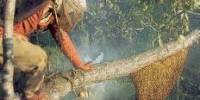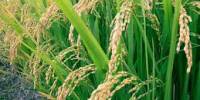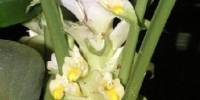FLUCTUATION AND SEASONAL ABUNDANCE OF Paracoccus marginatus
In the present study, the seasonal abundance of the insect pest, Paracoccus marginatus associated with unripe papaya fruit, in BCSIR experimental field of Dhaka city was investigated. The insects of P. marginatus were also collected from different localities of Dhaka city and BCSIR experimental Field. Relevant studies were carried out in the research laboratory of Zoology Section, BCSIR Laboratories, Dhaka.
Effect of temperature on the life history of the mealybug P. marginatus was investigated in the laboratory. P. marginatus developed and completed its life cycle at 18, 20, 25 and 30 ± 10 C. Females passed through 3 instars whereas males had four instars. Males have longer developmental time (27-30 days) than those of females (24-26 days) at 25 ± 10 C, 65 ± 2% RH and 12 : 12 (L:D) Photoperiod.(Tanwar et al. 2010).
Temperature showed significant influence on the reproduction and multiplication of this mealybug. It also had pronounced effect on the seasonal abundance of the pest. The fluctuation and seasonal abundance of P. marginatus is presented.
According to the estimated minimum temperature thresholds for the adult males and females were 14.5 and 13.9oC respectively. For adult males, the estimated optimum and maximum temperature thresholds were 28.7 and 31.9oC and for adult females, they were 28.4 and 32.1oC, respectively. The ability of P. marginatus to develop, survive and reproduce successfully between 18 and 30oC suggests that it has the capability to develop and establish in areas within this temperature range.
With rapid development, high survival rate, and enormous reproductive capacity, P. marginatus population could potentially reach a high level. Thus, temperature and humid it (65-70% R.H.) fovoured the seasonal abundance and reproductive potential of the P. marginatus.
Papaya mealybugs are most active in warm and dry weather. The wax, which sticks to each ovisac and nymphs, also facilitate passive dispersal by equipment, animals or human beings. The female mealybug is not active and unable to fly. In fact, human beings greatly facilitate in the transport of these mealybugs. Long-distance movement is aided through transport of infested planting material and fresh fruits and vegetables from one end of a farm to the other or even across the country.
In May to July and October to December each year papaya mealybug infestation appears on above ground parts on leaves, stem and fruits as clusters of cotton-like masses. Papaya mealybug has only been recorded feeding on areas of the host plant that are above ground, namely the leaves and fruit.
The insect sucks the sap by inserting it stylets or beak into the epidermis of the leaf, fruit, stem and bud. While feeding, it injects a toxic substance into the leaves resulting in chlorosis, plant stunting, leaf deformation or crinkling, early leaf and fruit drop, a heavy deposition of honeydew and death of plants.
DAMAGE POTENTIAL OF P. marginatus
RESULTS AND DISCUSSION
During present study,P. marginatus was found to severely attack immature and mature papaya fruits and tender underneath leaves of this plant. Due to serious attack the pericarp of papaya fruit was damaged and growth of fruits were cuased to some extent. Ultimately the papaya fruits became unsuitable for human consumption. It was a striking feature to state that the infestation of this mealybug was initiated in the older or ripe leaves of the plants from lower portions. Then the population of P. marginatus was increased and the active nymphs and adults moved towards immature papaya fruits of the plant. The mealybugs were found gregariously sucking on the precarp of the unripe papaya fruits. The gregarious attacking nature are given bellow in Figs. A, B, C .
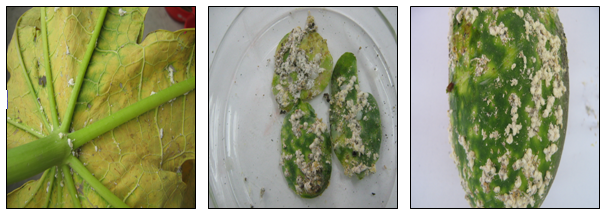
Fig. A) Papaya leaf infested with nyphal and adult stages of P.marginatus
B) P.marginatus infested an immature papaya fruit.
C) P.marginatus infested an matured papaya fruit.
Infestations of PMB occur along the veins of older leaves and on all parts of young leaves and fruits. Honeydew secreted by this mealybug results in the development of black Sooty mold that covers leaves, fruits and stems impeding photosynthesis and gaseous exchange. As a consequence, papaya trees die within a few months after infestation. (Muniappan 2008).
The peak infestation of P. marginatus was during from the month of April- August, 2011. The minimum infestation was noticed during September to October each year. Due to severe infestation, premature falling of leaves and immature papaya fruits occur.
Paracoccus marginatus is a small polyphagous sucking insect. It has been recorded from 22 plant families. Infestation of the mealybug appears as clusters of cotton-like masses on the above-ground portion of plants with long waxy filaments. Immature and adult stages of P. marginatus suck the sap of the plant and weaken it. The leaves become crinkled and wrinkled yellowish and wither. The honeydew secreted by the bug and associated black sooty mould formation hampers photosynthetic efficiency of the affected plants (Tanwar et al. 2010).
Healthy plants might be infested from mealybug infested plants as juvenile mealybugs crawl from an infested plant to another plant. Small ‘crawlers’ get readily dispersed by wind, rain, irrigation water, birds, ants, clothing, and vehicle etc. So, the population of P. marginatu gradually increases. In certain crops like cotton, stems which often carry mealybug infestation are stocked in the farm for propagation or other purposes. These stocks, near the newly planted crop act as reservoirs of papaya mealybug ( Tanwar et al. 2010).
The papaya mealybug feeds on the sap of plants by inserting its stylets into the epidermis of the leaf, as well as into the fruit and stem. In doing so, it injects a toxic substance into the leaves. The result is chlorosis, plant stunting, leaf deformation, early dropping of leaves and fruits a heavy accumulation of honeydew, and death of the host plants. Heavy infestations are capable of rendering fruit inedible due to the deposition of thick white wax by this mealybug has only been recorded feeding on different locations of the host plant that are above ground, namely the leaves and fruits.
Black and Red ants, attracted by the honeydew, have been seen carrying mealybug from plant to plant. So, ants act as a mode of dispersal of this noxious insect pest.
Mealybugs are known to offer ants with their sugary secretion (honeydew) and in return ants help in spreading the mealybugs and provide protection from predator ladybird beetles, parasitoids and other natural enemies, Ants also keep the papaya mealybug colony clean from detritus that accumulate in the secreted honeydew, which may be harmful to the mealybug colony. Some small and big ants i.e; Oecophylla smaragdina,Componotus compressus, have been found attending papaya mealybug, feeding on honeydew on jatropha, papaya and other plants. So, it is apparent that the ants act as a symbiotic agent for betterment, survival and wide dispersal of P. marginatus.
CONTROL STRATEGIES OF P.marginatus
The papaya mealybug colonize at the lower side of the papaya leaves along the veins and later move to unripe fruits rendering them unmarketable and inedible for human consumption. The loss appeared to be in the range 70-95 percent in my present study. Generally young plants are killed due to heavy infestation and colony formation of this mealybug.
P. marginatus is a polyphagous pest attacking several agricultural, horticultural crops and weeds of economic value.
P. marginatus Williams and Granara de Willink (Hemiptera : Pseudococcidae) a pest in Central America and the Caribbean, was noted to have been established on Palau in March 2003 and was causing serious damage to papaya and other plants. Chemical control is only partially effective and requires repeated and multiple applications. The chemical insecticides are recommended as the last weapon to the suppression of mealybug such as profenophos 50EC (2 ml/litre), chlorpyriphos 20 EC (2 ml/litre), buprofezin 25 EC (2ml/litre), dimethoate 30 EC (2 ml/litre), thiomethoxam 25 WG (0.6 g/litre), imidaeloprid 17.8 SL(0.6 ml/litre).
Active ingredients in registered pesticide formulations include acephate, carbaryl, chlorpyrifos , diazinon, dimethoate, malathion and white mineral oils. Typically, twice the normal dose is applied when treating for mealybugs because mealybugs are protected by thick waxy, cottony sacs, and often are concealed inside damaged leaves and buds. Thus, chemical controls are only partially effective and require multiple appilactions.
Furthermore, problems with insecticide resistance and non-target effects on natural enemies make chemical control a less desirable control option to combat the papaya mealybug.Natural enemies of the papaya mealybug include the commercially available mealybug coleopteran predator, Cryptolaemus montrouzieri, lady beetles, lacewings, and hover flies, all which are generalist predators that have a potential impact in the suppressions of mealybug population. In addition to predators, several parasitoids may attack papaya mealybug.
In 1999, the USDA Animal and Plant Health Inspection Service (APHIS)and USDA Agricultural Research Service (ARS) initiated a classical biological control programme for the papaya mealybug. Four genera of encyrtid endoparasitoid wasps specific to mealybug were collected in Mexico cooperators as potential biological control agents viz.
1. Acerophagus papayae (Noyes and Schauff)
2. Anagyrus loecki (Noyes and Menezes)
3. Anagyrus californicus compare, and
4. Pseudaphycus sp.(USDA 1999, 2000; Meyerdirk and Kauffman 2001).A fifth collected species was later reared and identified as Pseudleptomastix mexicana (Noyes and Schauff 2003). 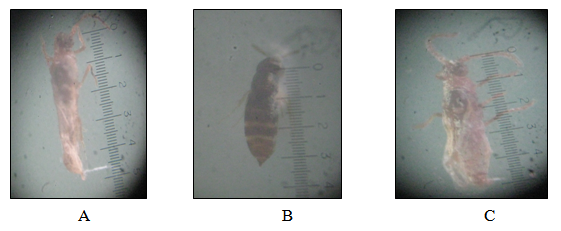
Fig. A) A braconid parasitoid found in association with P.marginatus
B) An encyrtid parasitoid found in association with P.marginatus
C) Another braconid parasitoid found in association with P.marginatus
All four species were screened in USDA/ARS quarantine facilities in Newark. Delaware and environmental assessments were completed (USDA-APHIS 1999,2000,2002). Specimens were then shipped to Puerto Rico where they were cultured and massreared for experimental release in Puerto Rico and the Dominican Republic . The first releases of these four parasitoids were made in Florida in October, 2000. APHIS has conducted the release of the four genera of parasitoid wasps has brought a 99.7% reduction in the density of mealybug population at research sites in the Dominican Republic, and a 97% reduction at research sites in Puerto Rico, with parasitim levels between 35.5% and 58.3% (Kauffman et al. 2001, Meyerdirk and Kauffman 2001). All four species of parasitoids have been observed attacking second and third instars of P. marginatus. However, Acerophagus sp. emerged as the dominant parasitoid species in both Puerto Rico and the Dominican Republic (Meyerdirk and Kauffman 2001). The out-come of releases of the four parasitoids in Florida is yet to be determined as released in March 2003.
The papaya mealybug has been controlled successfully by the parasitoid Acerophagus papayae Noyes and Schauff (Hymenoptera: Encyrtidae) imported from Puerto Rico where A. papayae appeared to provide 99% effective control. Biological control, which is the most successful method of control of this pest has been successfully implemented in Florida, Caribbean Islands, countries in South America, Guam and Palau. Sri Lanka, too, is in the process of importing the parasitoid, A. papayae introduced in May 15, 2009.
There is a need to conserve the native predators of the pest. Australian ladybird beetle (Cryptolaemus montrouzieri) predates on mealybugs, eating 3,000-5,000 mealybugs in various life stages and is released @ 10 beetles per tree or @ 5,000 beetles/ha.
Exotic parasitoids/predators such as Anagyrus loecki, Acerophagous papayae and Pseudleptomastrix mexicana (Hymenoptera: Encyrtidae) were released in Sri Lanka in May 2009 (imported from Puerto Rico) and resulted in 95 to 100% control of the papaya mealybug in some parts of that country by August 2009.
There is a need to introduce such exotic parasitoids in India and Bangladesh to control P. marginatus and to maintain pollution free environment . Further, it is suggested to locate ant colonies and destroy them with drenching of chlorpyriphos 20 EC @ 2 ml/litre of water which may be a part in the suppression of this mealybug.
Biopesticide Control Approach of P. marginatus.
In this chapter effect of some biopesticides on the mortality of nymphal and adut of P. marginatus have been evaluated. The potential biopesticides which were selected were : tobacco leaf (with stalk) extract, Neem seed oil, Mehgoni seed oil and castor seed oil.
Regular monitoring of the crop for occurrence of mealybug infestation and its natural enemies were performed . Biopesticide application were started immediately after noticing mealybugs on some papaya plants in the field conditions.
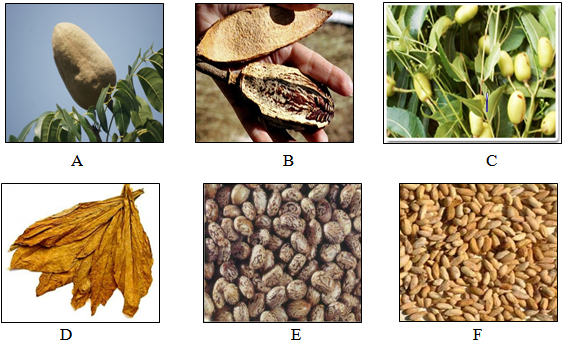
Fig. A) Mehgoni fruit
B)Dried Mehgoni Seed
C)Neem fruits
D) Dried Tobacco leaf
E) Dried Castor Seed
F) Dried Neem Seed
Biopesticides or botanicals such as Neem seed oil (5%), Mehgoni seed oil (5%), Castor seed oil (5%), dried tobacco medicine (100%), dried tobacco leaf extract (20%), were sprayed to the affected leaves and immature and mature fruits of different papaya plants containg mealybugs. Four fruits were ripen and these fruits were earlier sprayed by MO(5%) during end of April, 2011. The fruits were not palatable because of severe attack of mealybug infestation. The nymphs and adults of P. marginatus sucked the pericarp by immature and mature fruits by inserting their stylets into them. So, distate occurred. On the other hand, the ripe papaya fruits from uninfested papaya plants were tasty. Observations were made after 24 hours to determine the effect of these Biopesticidies on the mortality of the mealybugs, if any.
A control experiment was maintained having mealybug intestation untreated. The mortality in different treatments were counted and recorded carefully for 3 consecutive days. The effect of different biopesticides on the mortality of P. marginatus is presented in Table 07.
Table-07: Effect of different some biopesticides on the mortality of nymphs and adults of P. marginatus attacking papaya fruits.
Sl. No. |
Bio-pesticides applied |
| Total Number of mealybugs found | Observed after treatment Nos.of alive mealybug (nymph+adult) | Observed after treatment Nos. of dead mealybug (nymph+adult) | Mortality % |
1 | Dried tobacco medicine 100% | Adult | 7 | 1 | 6 | |
| Nymph | 267 | 17 | 250 | 93.43% | ||
| Total | 274 | 18 | 256 | |||
2 | Dried tobacco leaf extract 20% | Adult | 44 | 26 | 18 | |
| Nymph | 275 | 75 | 200 | 68.37% | ||
| Total | 319 | 101 | 218 | |||
3 | Mehgoni seed oil 5% | Adult | 1000 | 1000 | ||
| Nymph | 4000 | 1000 | 3000 | 80% | ||
| Total | 5000 | 4000 | ||||
4 | Castor seed oil 5% | Adult | 15 | 9 | 6 | |
| Nymph | 208 | 38 | 170 | 78.92% | ||
| Total | 223 | 47 | 176 | |||
5 | Neem seed oil 5% | Adult | 42 | 5 | 37 | |
| Nymph | 49 | 4 | 45 | 90.11% | ||
| Total | 91 | 9 | 82 | |||
6 | Control plant | Adult | 150 | 150 | 150 | |
| Nymph | 600 | 600 | 600 | 0% | ||
| Total | 750 | 750 | 750 |
The highest mortality of P. marginatus(93.43%) was observed in tobacco medicine(100%) concentration and lowest (68.37%) in 20% dried tobacco leaf extract followed by 90.11%, 80%, 78.92% in Neem seed oil, Mehgoni seed oil and castor seed oil respectively.
This observation was based on single papaya leaf and fruit. All papaya leaves under observation were fresh and greenish in colour.
Mealybug control often involves control of attendant ants that are important for the proper development of the mealybugs. Without the ants, mealybug population is small and slow to invade new areas and the field would be free of severe mealybug infestation. Therefore, management of mealybugs often includes the control of ant species.
For management of mealybugs, it is important to know the species present as management programmes for the various mealybugs may differ, plant protection products are of limited effectiveness against mealybugs because of the presence of waxy covering of its body. Management strategies P. marginatus usually involves the following approaches. The strategies given below are based on previous findings and own observations.
i) Monitoring and scouting are needed to detect early presence of the mealybug.
ii) Pruning of infested branches and burning them.
iii) Removal and burning of crop residues.
iv) Removal of weeds/alternative host plants like papaya, hibiscus, parthenium etc. in and nearby crops.
v) Avoiding the dispersal of planting material from infested areas to other areas.
vi) Avoiding irrigation upto the top levels of the lands.
vii) Prevention of the dispersal of ants and destruction of already existing ant colonies.
viii) After pruning, the cuttings of infested shrubs or trees lying around should be immediately burnt.
ix) Shaking of the infested material is prohibited.
x) Proper phytosanitation of plating material, harvested produce etc, before moving to other states is necessary.
xi) Intensive regular survey should be made to find out efficient parasitoids/ predators/ pathogens of the P. marginatus, if occurs any.
xii) Chemical insecticide spraying restriction unless mealybug infestation is confirmed. Unnecessary spraying may destroy natural enemies which keep mealybug population under control.
xiii) Sterilization of farm equipments to be performed before using them to the uninfested crops.

